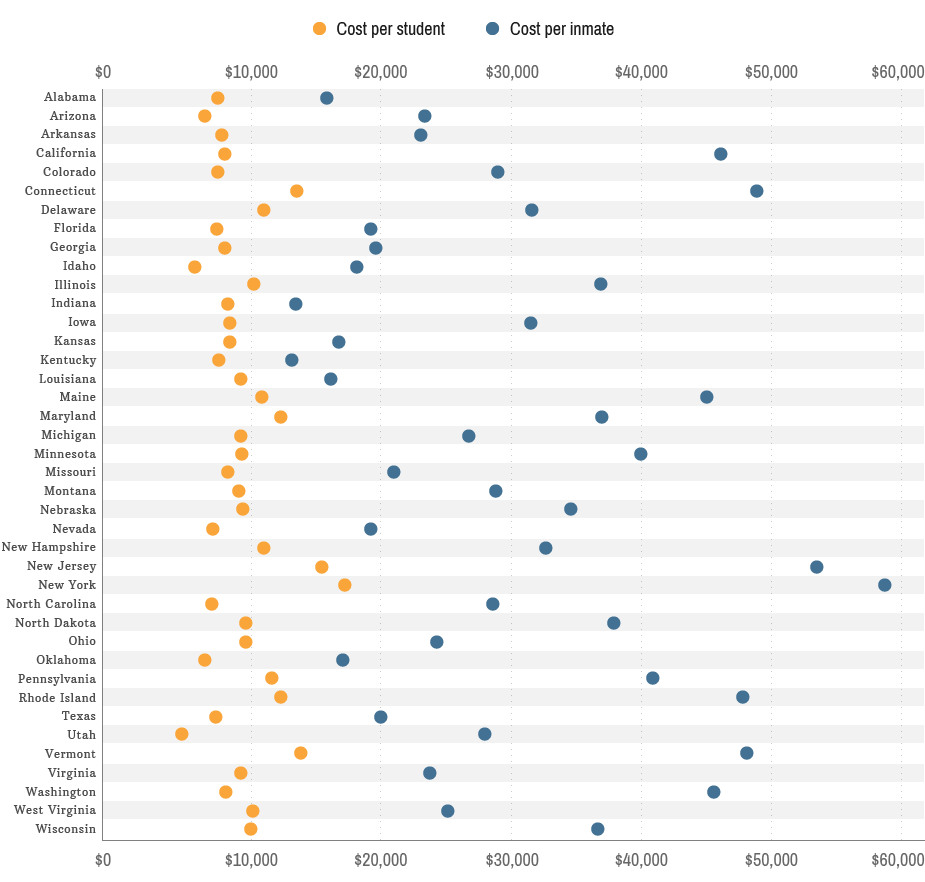I was shocked by a statistic I heard for the first time at the NACDL conference last month. The United States spends three times more money to incarcerate its citizens than it does on K-12 Education!
That’s horrible! Not only does it show how grossly disproportionate our country’s priorities are, but it helps explain why we have such a high incarceration rate.
A high percentage of individuals entering into the prison system are uneducated and lack basic skills necessary to earn a decent living. So what do we do? We take these people and warehouse them for 5, 10 or even more years and then release them no better than when they came in. In fact, they are worse – they still are uneducated and lack skills, but they now have the stigma of a felony on their record plus the psychological damage that a long prison sentence produces.
According to the US Department of Justice, Bureau of Prisons, Annual Determination of Average Cost of Incarceration, the fee to cover the average cost of incarceration for Federal inmates was $36,299.25 ($99.45 per day) in FY 2017. Compare that to the cost of education. According to the College Board, the average cost of tuition and fees for the 2017–2018 school year was $34,740 at private colleges, $9,970 for state residents at public colleges, and $25,620 for out-of-state residents attending public universities.
We’re not suggesting that getting arrested should be a free ticket to a college education, but there are clearly more efficient and cost-effective ways of dealing with prison inmates than pure incarceration. At least ones that return people to society better off than when they came in. As was suggested during the conference; the things that keep people from coming back to prison are the same things that keep people from going there in the first place – education, a decent job, housing stability.
By incorporating “rehabilitation” into “corrections” (corrections might be a misnomer, since nothing is being “corrected”), at least the government has a chance of getting a return on their spend in the form of lower recidivism.
We also need to focus more effort on prevention, rather than punishment. The chart below speaks for itself. Spending more on K-12 education than on incarceration is where crime prevention needs to start!


No surprise here. Prisons provide a better return on investment for politicians, in terms of kickbacks and power. Schools provide nothing for them but bad press.
Where is Mass.?
…and where is Hawaii??
Ask CNN, they only collected data from 40 states:
https://money.cnn.com/infographic/economy/education-vs-prison-costs/
During my 12 years in Michigan prison, there was great frustration that most of the training programs had been eliminated. They do offer some college courses now, and i have friends there that are taking advantage of it. My job in prison was mostly as an Academic Tutor, preparing students for taking the GSD test. I was amazed at how many men over 50 I met who had never learned to read. Something is seriously wrong with an educational system that allows that to happen.
We also have a great need for a return to a more secular society in regards to education in particular. It has been shown unequivocally that the more secular a country is, the lower the crime rate.
In our country, lawmakers are continually lobbied by corporations that own and operate private prisons. As time has marched ever toward this corporate incarceration nation, we have seen ever ambiguous laws enacted to entrap otherwise lawful and innocent citizens into the impossible to escape penal system our uneducated and non-scientific oriented senators, congresspeople, and lawmakers push to enact in SPITE of all data which PROVES contrary to their unwavering stance, buttressed by money and a faith-based stances rejecting any science or statistics proving them wrong.
The deeper you dig into the statistical crime model of our great country, you will see the inherent flaws in the evangelical position poisoning our society with higher crime rates, higher repeat teenage pregnancy rates, and lower overall education levels. These statistics are most notable in the deep south states, including Tennessee, Alabama, Arkansas, Mississippi, Texas, and Kansas, to name a few. In these states, the crime rates are FAR above the national averages per capita, and the most racially unbalanced. In a nutshell, those states which teach creationism in public schools are the ones with the worst esucational and criminal track records.
As RSO’s, we need to band together and educate ourselves on this subject of statistcs, laws, and criminality which governs our lives.
Get a college education. Pell grants are free and will pay for your tuition and books.
My education began in drafting and design, but that changed when I moved to another college and many credits were not transferable. I’m now in an engineering program.
No matter your course of study, the education process alone will help you compile your thoughts and information and to be more articulate in your presentations.
Educating yourself is the only way we can beat this hydra. Education is the only way we can learn to educate others. Why not make the government pay for it? That’s what it’s there for. Use it. Or, relegate yourself to being a puny, infested pile of dog excrement society has been lured into believing you are. Forever. It’s your choice.